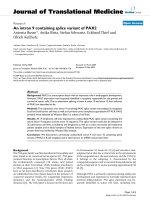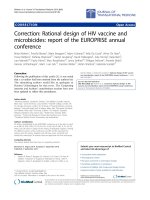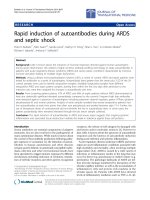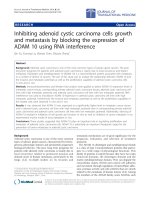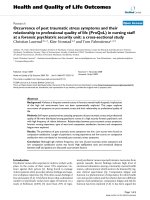Báo cáo hóa học: " Advanced 3D indoor propagation model: calibration and implementation" ppt
Bạn đang xem bản rút gọn của tài liệu. Xem và tải ngay bản đầy đủ của tài liệu tại đây (6.97 MB, 10 trang )
RESEARCH Open Access
Advanced 3D indoor propagation model:
calibration and implementation
Ludek Subrt
*
and Pavel Pechac
Abstract
A software tool, implementing a semi-deterministic model which provides swift predictions, accounts for all
significant physical phenomena while utilising a clear-cut description of material properties, is presented in this
article. The software can predict signal coverage, delay profiles and angle of arrivals for receivers located anywhere
in a scenario using three probabilistic parameters to describe each of the materials. Probabilistic parameters can be
efficiently optimised based on measured data by a genetic algorithm optimiser contained in the software tool
enabling real material properties (constants) to be avoided. The semi-deterministic model is briefly described
whereas its implementation into the tool is explained in greater detail. Measured narrowband, as well as wideband,
data are presented, and the basic principles of the computer optimisation utilised in the tool are shown. Optimised
results are compared with the measured ones and deviation is determined. The principle of a simple multi-
threading algorithm which improves the tool performance while decreasing time consumption is presented along
with computational times where a different number of threads are compared.
Keywords: oftware tool, electromagnetic wave propagation, modelling, indoor scenarios, ray launching, genetic
algorithms, computer optimisat ion
1. Introduction
The design of modern, effici ent, wireless systems
requires site-specific planning. The location of the base
stations forming modern digital systems is optimised on
the basis of path-loss predictions for providing users
with coverage enablin g reliable, high-speed data trans-
fers. Path-loss predictions can sometimes provide
incomplete information on the radio channel as they do
not provide information o n fading characteristics since
they do not fully consider multipath propagati on. Such
characteristics as impulse response (delay profile) or
angle-of-arrival (AoA) predictions can complete the
information provided by path-loss predictions and
improve the design performance.
Many models for indoor propaga tion predictions have
already been proposed [1-3]. There are many possible
classifications of these, but two basic groups are usually
identified. One group, the empirical models (e.g. One
Slope Model [4]), utilises relatively simple formulas con-
taining empirical parameters to estimate path-loss and
therefore do not require a database of exact positions of
obstacles. They provide rapid predictions, but due to
their relatively simple principle of function the y cannot
achieve a high level of accuracy. The second group, the
deterministic models (e.g. Full-wave, Ray-optical or
Moment-method models [4]), is based on an approach
requiring an accurate and complete database of obsta-
cles including their material properties. This approach
uses a rigorous description of electromagnetic wave pro-
pagation, which is, unfortunately, characterised by high
time consumption. Most deterministic models utilise the
Finite-Difference Time-Domain method (a full-wave
method based on the numerical solution of Maxwell’s
equations [4]), Ray-tracing (Ray-optical method based
on finding all possible paths between the transmitter
and receiver [5]) or a similar approach (to find all signif-
icant paths between the transmitter and receiver) in
combination with electromagnetic field theory (to solve
ray/obstacle interaction using Fresnel equations and
UTD/GTD [6]). Ray-optical methods fail when the size
of the obstacles is not much larger than a wavelength,
while full-wave methods require an extremely long
amount of time and memory to run.
* Correspondence:
Department of Electromagnetic Field, Czech Technical University in Prague,
Technicka 2, 166 27, Prague 6, Czech Republic
Subrt and Pechac EURASIP Journal on Wireless Communications and Networking 2011, 2011:180
/>© 2011 Subrt and Pechac; licensee Springer. This is an Open Access article distribu ted under the terms of the Creative Commons
Attribution License (http://creativecomm ons.org/licenses/by/2.0), which permits unrestricted use, distribution, and reproductio n in
any medium, provided the original work is prop erly cited.
Apartfromthetwomodelcategoriesmentioned
above, we can distinguish two other groups of models
which cannot be classified into either of the basic cate-
gories as they use a combination of deterministic and
empirical approaches which we refer to as semi-empiri-
cal and semi-deterministic models. Semi-empirical mod-
els (e.g. Multi-Wall Model) benefit from a speedy
empirical approach, but in contrast to pure empirical
models, account for materials and the position of obsta-
cles. Semi-deterministic models (e.g. Dominant Path
Model [7], Motif Model [8]) r epresent a compromise
between time-consuming deterministic models and less
accurate empirical models. In general, the semi-determi-
nistic models use a rigorous physical approach which is,
in contrast to deterministic models, simplified in certain
respects. For example, the time-consuming solution of
ray/obstacle interactions usually computed by Fresnel
equations and UTD/GTD can be replaced, for example,
by simple, straightforward probabilistic relations [9].
There are many software tools employing a variety of
models on the market today. Some representative com-
mercial tools are EDX [10], Winprop [11] and Ranplan
software [12], in addition to some non -commercial tools
as well such as the Grass- Raplat project [13]. The mod-
els featured in such tools are usually modified by a
developer to return highly accurate results and decrease
computation time. Most software tools provide fast
sim ulations; thanks to accelerating methods such as t he
pre-processing of the obstacle database [14], but the
majority of these tools do not take material roughness
and diffuse scattering into account effectively. Another
disadvantage is that models necessitate detailed knowl-
edge of material properties when solving ray/obstacle
parameters which cannot be optimised in a straightfor-
ward way since the number of parameters and rays is
usually too high for a fast calibration.
We have developed a tool which, in contrast to public
available tools, effectively models material roughness.
Moreover, material properties are defined using only
four parameters tuned by measurements, which is an
unequivocal and effective way of material description.
The aim of this article is to prese nt a propagat ion tool
utilising a 3D site-specific model considering all signifi-
cant physical phenomena (penetration, reflection, dif-
fraction and diffuse scattering) while providing both
narrowband (signal coverag e) and wideban d predictions
(delay profile, AoA), thus enabling detailed designs of
indoor scenarios and fast semi-deterministic calculations
based on a simplified approach. Unlike many other site-
specific models, our model does not require a database
of material properties which form obstacles in a scenario
as the material properties are replaced by a few prob-
abilistic parameters which are optimised by means of a
measurement campaign.
The rest of this article is organised as follows: The fol-
lowing section briefly describes the basic principles of
the model implemented in the software tool. Sections 3
and 4 deal with model implementation and calibration,
respectively. The fifth section, featuring a brief descrip-
tion of test scenarios, a measurement campaign and
model calibration, deals with the tool perfo rmance veri-
fication. The section also shows a compelling compari-
son of simulation time-consumption performed with a
variety of threads, as well as the difference in computa-
tional time between a pre- processed scenario and a sce-
nario without pre-processing. The last section
summarises the features and benefits of our tool.
2. Propagation model
The principles of the 3D model for indoor propagation
predictions implemented in our tool, which are com-
pleted by diffraction phenomena, are based on the algo-
rithms developed for long, straight tunnels [9]. The
model is based on a fast semi-deterministic approach
utilising the modified Ray-Launching method, where
electromagnetic waves are substituted by a high number
(an infinite number in an ideal case) of plane waves
represented by their directional vectors/rays.
The underlying principle of our method is based on
the presumption that each ray launched from the trans-
mitting antenna carries an equal part of the overall
transmitter power given by the number of launched rays
and overall power. Rays are launched from the transmit-
ting antenna according to an antenna radiation pattern
(Figure 1a) which is converted into a launching pattern
(Figure 1b) [9], thereby determi ning the number of rays
that are launched in specific directions.
A launching pattern, based on the antenna pattern, is
created (Figure 1a) by firstly transforming values of
directivity to the probabilistic values, meaning that each
angle is assigned with a launch probability. On the basis
of this probability, the distribution function (Figure 1c)
is created. If an extremely large number of rays is
launched, the launching pattern provides a perfect
approximation of the real antenna pattern.
First and foremost, a random number is generated and
a corresponding angle is chosen by means of the distri-
bution function. Once a ray is l aunched from the trans-
mitter, the intersection with an obstacle is found and
the AoA is computed. The subsequent direction of the
impinging ray i s determined by means of what is
referred to as a probability radiation pattern (PRP)
(Figure 2) which determines the probability of the sub-
sequent direction of the impinging ray for each spatial
AoA. This implies that a single, new ray is gen erated,
instead of the impinging ray, while all significant phe-
nomena (reflection, penetration, absorption and diffrac-
tion) are taken into account. The amplitude and phase
Subrt and Pechac EURASIP Journal on Wireless Communications and Networking 2011, 2011:180
/>Page 2 of 10
of the power carried by the rays is not taken into
account and received power is given by the number of
rays reaching the receiver, which, together with a rapid
calculation of ray/obstacle interaction, decreases the
time needed for computation. The implication being
that our model predicts the mean value of the received
power.
The PRP consists of two parts: A directional part
expressin g a specu lar reflection proportional to the AoA
of an impinging ray, and an omni-directional part which
expresses diffuse scattering and is independent of the
AoA. The overall probability pattern is given by the sum
of these two parts (Figure 2a).
The PRP for flat sections of obstacles is formed by
means of only t hree probabilistic parameters –the prob-
ability of absorption (p
A
), reflection (p
RT
) and diffuse
scattering (p
DS
)–which can be obtained on the basis of
measur ement and computer optimisation. The probabil-
ity of absorption is define d as the ratio of absorbed and
incident power. The probability of reflection is repre-
sented by a ratio of reflected and em itted power (Figure
2b). The probability of diffuse scattering (Figure 2c) is
defined as the ratio of the omni-directionally emitted
power and the overall emitted power. A detailed deriva-
tion and description of the aforementioned parameters
can be found in [9].
To take into account the influence of diffraction, we
have defined a new parameter–a diffraction distance
( D
DIF
) representing the distance from the edge where
the ray is thought to be diffracted (Figure 3a). If a ray
impinges the obstacle within a distance less than the dif-
fractiondistancefromtheedge,itisdiffractedandits
subsequent direction will be determined by a corner
PRP which differs from the PRP for the flat section of
the obstacle. By and large, the diffraction distance
depends on wavelength, the material of the obstacles
(walls) and their arrangemen t, as well as on other prob-
abilistic parameters. As with the aforementioned prob-
abilistic parameters, the value of the diffraction distance
is either optimised or set as a constant (see Section 5.2).
However, it is recommended to s et the d iffraction dis-
tanceequaltothegridsizeasitsignificantlydecreases
Figure 2 PRP–forming; probability of reflection and diffuse scattering.
Figure 1 Forming launching pattern and launching rays.
Subrt and Pechac EURASIP Journal on Wireless Communications and Networking 2011, 2011:180
/>Page 3 of 10
the time needed to determine the usage of either the flat
part or corner PRP. This approach reaps benefits in the
form of a rapid determination of the subsequent dire c-
tion of an impinging ray while accounting for the
approximate shape of the diffraction pattern based on
measurements [15].
As was already stated, the description of materials by
probabilistic parameters and diffraction distance is bene-
ficial since material properties required for accurately
computing ray/obstacle interactions, including diffrac-
tions, are not usually known.
3. Model implementation
The principles of the developed model were written into
C# language code and equipped with a graphical user
interface. The most important parts of the algorithm are
described as follows (Figure 4).
After the simulation launch, all relevant information
set by the user (information on site, transmitter and
receivers, requested outputs, etc.) are integrated and the
variables are adjusted to create a database of PRPs for
all materials found in the scenario. If there is no pre-
processed database of obstacles, the scenario is pre-pro-
cessed according to a method using space division
described in detail in [14]. The next step is to divide the
computation into more parallel threads if the user
requires a multi-thread calculation. The multi-thread
computation is suitable for computers equipped with
processors with more than one computati onal core as it
decreases computational time significantly (see Section
5.4). We performed simulations on an Intel Core i7
computer, with four computational cores and hyper-
threading technology, meaning that the tasks can effec-
tively be computed in eight parallel threads. However,
theoretically, the number of parallel threads in our soft-
ware is not limited.
After the parallelisation of th e computation, the main
loop begins and a ray is launched from the transmitter; it
propagates within the scenario and passes through grid
elements which are recorded into a database of results
until a ray/obstacle intersection is found. When an inter-
section is found and the ray is not absorbed, the subse-
quent direction of the impinging ray is determined by
means of the PRP corresponding to the material of the
intersected obstacle. When the ray is absorbed or leaves
the scenario, the current iteration is terminated and the
next one only begins when a sufficient number of rays
providing an accurate prediction has not yet been
launched. One way to determine if there is a sufficient
number of rays is to co mpare current results with the
results before the launch of a certain number of rays (e.g.
before one millio n iterations). If the results are the same
(i.e. the difference is less than the predefined threshold),
then a sufficien t number of rays has been launche d. If
not, another assortment of rays needs to be launched.
The loop described above is computed in parallel fash-
ion in all threads, the final results are combined, and the
overall results are calculated as the sum of these parti-
cular results.
4. Model optimisation
Werecommendthatthemodelbecalibratedbythe
optimisation tool ut ilising principles of computer opti-
misation, several of which have already been published
[16]. We chose a calibration technique based on the
genetic evolutionary algorithms [17].
Each individual [17] represents a set of four para-
meters–probability of reflection, absorption and diffuse
Figure 3 The PRP for flat sections of an obstacle and a corner.
Subrt and Pechac EURASIP Journal on Wireless Communications and Networking 2011, 2011:180
/>Page 4 of 10
scattering, and diffraction distance. The optimisation
process, as shown in Figure 5, is a process of model tun-
ing (optimisation) based on running repeated narrow-
band simulations of a scenario (Figure 4) with
probabilistic parameters of obstacles (materials) set
before each simulation. Results provided by the simula-
tion process are compared with the measured (target)
data and the difference is determined. When the differ-
ence is equal to zero or lower than a predefined value,
the optimisation (tuning) process is finished and prob-
abilistic parameters are set to values to provide results
corresponding to the measured data. Accordingly, the
model can easily be adjusted, by means of measured
data, to any scenario by using just a few probabilistic
parameters.
5. Tool performance verification
As mentioned earlier in this article, the model imple-
mented in the tool relies on measurements providing
data needed for the model calibration. Although a
measurement campaign is the most accurate method
to calibrate the model, it has one significant draw-
back–it can be time consuming and, therefore, costly
making it impossible to perform a measurement on
each scenario examined. A more effective way is to
choose a typical indoor scenario (primary scenario),
calibrate the model using measured data to obtain a
“universal” set of materials as a result of optimisation
process. This set of parameters should also be valid
for similar scenarios (secondary scenarios) using the
same frequency. If a different frequency is used, the
Figure 4 Flowchart of the simulation together with corresponding progress bar.
Subrt and Pechac EURASIP Journal on Wireless Communications and Networking 2011, 2011:180
/>Page 5 of 10
corresponding set of probabilistic parameters needs to
be deployed. To verify this idea, we performed the fol-
lowing test.
Astheprimaryscenario,wechoseafloorinouruni-
versity building (Figure 6a, Section 5.1) for which we
already had a detailed floor plan and approximate infor-
mation about wall materials. Floors inside a hotel (Dip-
lomat hotel in Prague –Figure 6b) and commercial office
building (Koospol comp any–Figure 6c) were chosen as
secondary scenarios because of limited information on
Figure 5 Flowchart of the optimisation process.
Figure 6 Test case scenarios–a floor inside CTU office building (primary scenario) and two secondary scenarios.
Subrt and Pechac EURASIP Journal on Wireless Communications and Networking 2011, 2011:180
/>Page 6 of 10
the floor plan and wall materials. Although built for dif-
ferent purposes, they have similar structures and func-
tions, all containing long corridors and many small
rooms.
5.1. Measurement campaign
To verify the function of our propagation tool, a mea-
surement campaign inside the primary scenario was car-
ried out. On the basis of a detailed construction plan, a
3D model of the floor (the sixth floor–Figure 6a) of a
Czech Technical University building in Prague was
made using the site builder tool, which is a part of our
software.
We defined five types of obstacles– light wall, heavy
wall, glass, metal and floor & ceiling. Colours in Figure
6 represent different types of obstacles and correspond
to the colours shown in Table 1.
The signal coverage measurement [18] (Figure 7) was
performed over 144 lines in the primary scenario at a
Table 1 Optimised probabilistic properties of obstacles
(1.9 GHz)
Colour Type of wall p
A
(-) p
DS
(-) p
RT
(-) D
DIF
(l)
Dark red Light wall 0.31 0.12 0.91 3
Light Brown Heavy wall 0.6 0.8 0.14 3
Light Blue Glass 0.21 0.24 0.03 3
Black Metal 0.04 0.58 0.41 3
- Floor & ceiling 0.19 0.30 0.36 3
Figure 7 Measured data (in 5,267 points) as displayed in our prediction tool (primary scenario).
Subrt and Pechac EURASIP Journal on Wireless Communications and Networking 2011, 2011:180
/>Page 7 of 10
frequency of 1.9 GHz. The output power of 25 dBm was
transmitted from a patch antenna at a height of 1.8 m
above floor level. Receiver dynamic r anged between -47
and -107 dBm. The height of the receiv ing antenna was
1.5 m.
Our tool predicts the mean value of path loss so the
measured data were averaged using a running RMS win-
dow of 20 l
0
for the lines measured in the corridor
(with a step of about 0.45 m) and of 5 l
0
elsewhere
(measurement with a step of 0.13 m). Figure 7 displays
measured data together with averaged values.
The impulse response (delay profile) measurement
[18] (Figures 8 and 9) was performed at five points in
the scenario (Rx 1-Rx 5 in Figure 7) by means of a vec-
tor analyser with an indirect time domain measurement.
The measurement dynamic was about 60 dB and the
time resolution about 0.1 ns.
Secondary scenarios (Figure 10) were measured using
the same equip ment, and data o btained from the mea-
surement was processed as in the case of the primary
scenario.
5.2. Optimisation process
The genetic evolutionary algorithms used for model
calibration had the following settings: the maximum
number of generations, as well as the number of indi-
viduals in each generation, was set to 30 based on our
experience with the optimiser and as a compromise
between performance (optimisation time) and target
precision. Individuals were modified by th e uniform
crossover and a roulette wheel was used as the method
of selection for the next generation. We chose five
calibration points according to Figure 7 (Rx 1-Rx 5).
However, for more complex scenarios we recommend
placing a calibration point in each room, or at lea st to
those locations where strong signal fluctuations are
expected.
The optimisation process automatically stopped dur-
ing the 20th generation when the fitness of the best
individual was better than predefined goal (3 dB
2
). The
resultant obstacle parameters are shown in Table 1. The
probabilistic parameters were set automatic ally using an
optimisation algorithm; diffraction distance was set, in
advance, to 3 l which is approximately equal to the size
of the grid used for predictions (0.5 m).
5.3. Results
Simulation accounting parameters, shown in Ta ble 1,
were performed to provide data to compare the mea-
sured and simulated data in the primary scenario. Fig-
ures 8 and 9 show a comparison of the measured data
and IR prediction.
Signal coverage provided by simulation was com-
pared with the averaged measured data (Figure 7) with
the mean value of the difference between predicted
results and measurement being -0.02 dB and a stan-
dard deviation of 6.91 dB. This demonstrates that the
results provided by our model are in good agreement
with the measured results. The best agreement is
reached at points where receivers are located and con-
versely, the worst agreement is at points far from
receivers.
The optimised values of probabilistic parameters were
also used for the other two sc enarios (Figure 6 b, c). A s
we did not have a detailed plan showing the posit ion of
walls, windows or information about materials, we mod-
elled the scenarios using only two kinds of materials–
light and heavy walls. Table 2 shows a comparison
among accuracy levels for each scenario expressed by
the mean value and standard deviation of the difference
between measured data and simulated results, in addi-
tion to the time needed for computation (on condition
that 10
9
rays were launched) . It is necessary to mention
that we used a 3D ray launching algorithm with no
form of post-processing or optimisation of number of
rays for the comparison.
Figure 8 Receiver no. 3– predicted and measured IR
(Rx 3–Figure 7).
Figure 9 Receiver no. 4– predicted and measured IR
(Rx 4–Figure 7).
Subrt and Pechac EURASIP Journal on Wireless Communications and Networking 2011, 2011:180
/>Page 8 of 10
Computation times show that the time needed for the
computation depends mostly on the size of scenario
since tracing of the rays is the most time-consuming
part of the algorithm. The number of obstacles has
almost no influence on time consumption; thanks to the
pre-processing method used.
The lower levels of accuracy were achieved for the
Diplomat Hotel and the Koospol building (i.e. secondary
scenarios) in comparison with the primary scenario
which was optimised on the basis of measured data.
Although mean values of difference, as well as stan-
dard deviations, indicate that probabilistic parameters
optimised for the primary scenario (and used for sec-
ondary scenarios) provide slightly lower performance
than comparable models [19] (devi ations between 5 and
8 dB), it can be considered as a satisfactory performance
with respect to the fact that a database of exact obstacle
positions and material properties was not available and
only approximated positions of obstacles were taken
into account.
5.4. Time-consumption analysis
To show the influence of the multi-thread computat ion,
as well as the pre-processing procedure, on time con-
sumption, we carried out several simulations at different
settings using the scenario described earlier. Parallel
computation was expected to speed up the computation
noticeably. Our computer was equipped with a quad
core processor and hyper-threading, consequently it is
able to effectively calculate up to eight parallel threads.
Figure 11 contains a comparison of computational times
for a particular number of threads, ranging fro m 1 to
12, in use.
As can be seen, a multi-thread computation has a
positive influence on c omputational time. An inverse
relationship between the number of used threads and
comp utational time can be observed for between one to
four threads. When the number of threads is between
four and eight, we still observe a slight rise in perfor-
manc e; thanks to the hyper-thr eadin g technology. How-
ever, a further increase of parallel computational threads
does not bring any benefit in the form of faster compu-
tation since the processor does not have the available
resources (cores) which could be used by other threads.
There is a pronounced influence of multi-threading on
computational time. Furthermore, the pre-processing
procedure based on the rectangular grid method [14]
Figure 10 Measured data (secondary scenarios: Diplomat–644 points, Koospol–710 points).
Table 2 Accuracy levels for scenarios
Scenario Mean (dB) Deviation (dB) Time (s)
CTU Building -0.02 6.91 192
Diplomat Hotel 2.34 8.15 336
Koospol Building 4.12 9.67 326
Figure 11 Time consumption versus number of active threads.
Subrt and Pechac EURASIP Journal on Wireless Communications and Networking 2011, 2011:180
/>Page 9 of 10
performed on the test scenario lasts less than 1 s, but
the resulting computation time is only 0.5% of the com-
putation time when not using any pre-processing
method.
6. Conclusions
A computationally efficient software tool for fast, site-
specific indoor predictions and optimisations has been
developed and presented. The utilised semi-determinis-
tic measurement-ba sed model provides immediate,
detailed predictions of both narrowb and and wideband
channels parameters. The model is based on unique
principles where interactions of the signal and the sce-
nario are solved stochastically while all physical phe-
nomenaofthewavepropagationareconsidered
simultaneously. Optimisation (tuning) of the model is
based on repeated simulations of a scenario, where
probabilistic parameters (four for each type of obstacle)
are set according to the comparison results of simulated
and measured data. This simple and efficient approach
provides the robust algorithm with fast convergence.
The prediction tool provides fast calculations of signal
coverage, delay profile and AoAs. The core of the pre-
diction tool uses a semi-deterministic model based on a
modified ray launching method and a unique way of sol-
ving ray/obstacle interaction and if a multi-core proces-
sor is used for calculations, the simulation can be
parallelised. Genetic algorithmsareabletooptimise
parameters of obstacles so that the model can be
adjusted according to the measured data.
The performance and accuracy of the prediction and
optimisation tool has been verified on the basis of mea-
sured campaigns conducted in off ice buildings. Both the
simul ated and measured results were compared and dif-
ferences were quantified and described.
Our model has the potential to be a powerful part of
future wireless systems and heterogeneous networks
design, where rapid detailedadhocpredictionsand
optimisations for reconfigurable multiple-antenna sys-
tems could be required.
Acknowledgements
This study was supported in part by the Czech Ministry of Education, Youth
and Sport Research (Project no. OC10005) “Intelligent Infrastructures for
Cognitive Networks” in the frame of the COST IC0902 project and WUN
Cognitive Communications Consortium.
Competing interests
The authors declare that they have no competing interests.
Received: 1 April 2011 Accepted: 23 November 2011
Published: 23 November 2011
References
1. S Saunders, A Aragon, Antennas and Propagation for Wireless
Communication Systems (Wiley & Sons, 2007)
2. MF Iskander, Y Zhengqing, Propagation prediction models for wireless
communication systems. IEEE Trans Microwave Theory Techniques 50,
662–673 (2002). doi:10.1109/22.989951
3. A Goldsmith, Wireless Communications (Cambridge University Press, 2005)
4. TK Sarkar, J Zhong, K Kyungjung, A Medouri, M Salazar-Palma, A survey of
various propagation models for mobile communication. Antennas Propagat
Mag IEEE 45,51–82 (2003). doi:10.1109/MAP.2003.1232163
5. SY Seidel, TS Rappaport, Site-specific propagation prediction for wireless in-
building personal communication system design. IEEE Trans Veh Technol.
43, 879–891 (1994). doi:10.1109/25.330150
6. RG Kouyoumjian, PH Pathak, A uniform geometrical theory of diffraction for
an edge in a perfectly conducting surface. Proc IEEE 62, 1448–1461 (1974)
7. G Wolfle, FM Landstorfer, Dominant paths for the field strength prediction,
in 48th IEEE Vehicular Technology Conference, VTC 98. 1, 552–556 (1998)
8. P Pechac, M Klepal, Effective indoor propagation predictions, in IEEE VTS
54th Vehicular Technology Conference, 2001. Fall VTC 2001. 3, 1247–1250
(2001)
9. L Subrt, P Pechac, Semi-deterministic propagation model for subterranean
galleries and tunnels. IEEE Trans Antennas Propagat. 58, 3701–3706 (2010)
10. EDX Wireless, . Accessed 25 July 2011
11. AWE Communications, . Accessed 25
July 2011
12. Ranplan, Accessed 25 July 2011
13. GRASS-RaPlaT, Accessed 25 July
2011
14. Y Zhengqing, MF Iskander, Z Zhijun, A fast ray tracing procedure using
space division with uniform rectangular grid, in IEEE Antennas and
Propagation Society International Symposium, 2000. 1, 430–433 (2000)
15. P Valtr, P Pechac, Diffraction calculations and measurements in millimeter
frequency band. Radioengineering 13,98–104 (2004)
16. E Eiben, JE Smith, in Introduction to Evolutionary Computing (Springer, 2003)
17. KF Man, KS Tang, S Kwong, Genetic Algorithms: Concepts and Designs with
Disk (Springer Inc., New York, 1999)
18. S Zvanovec, P Pechac, M Klepal, Wireless LAN networks design: site survey
or propagation modeling? Radioengineering 12,42–49 (2003)
19. P Wertz, G Wolfle, R Hoppe, FM Landstorfer, Deterministic propagation
models for radio transmission into buildings and enclosed spaces. 33rd
European Microwave Conference, 2003, 1147–1150 (2003)
doi:10.1186/1687-1499-2011-180
Cite this article as: Subrt and Pechac: Advanced 3D indoor propagation
model: calibration and implementation. EURASIP Journal on Wireless
Communications and Networking 2011 2011:180.
Submit your manuscript to a
journal and benefi t from:
7 Convenient online submission
7 Rigorous peer review
7 Immediate publication on acceptance
7 Open access: articles freely available online
7 High visibility within the fi eld
7 Retaining the copyright to your article
Submit your next manuscript at 7 springeropen.com
Subrt and Pechac EURASIP Journal on Wireless Communications and Networking 2011, 2011:180
/>Page 10 of 10




